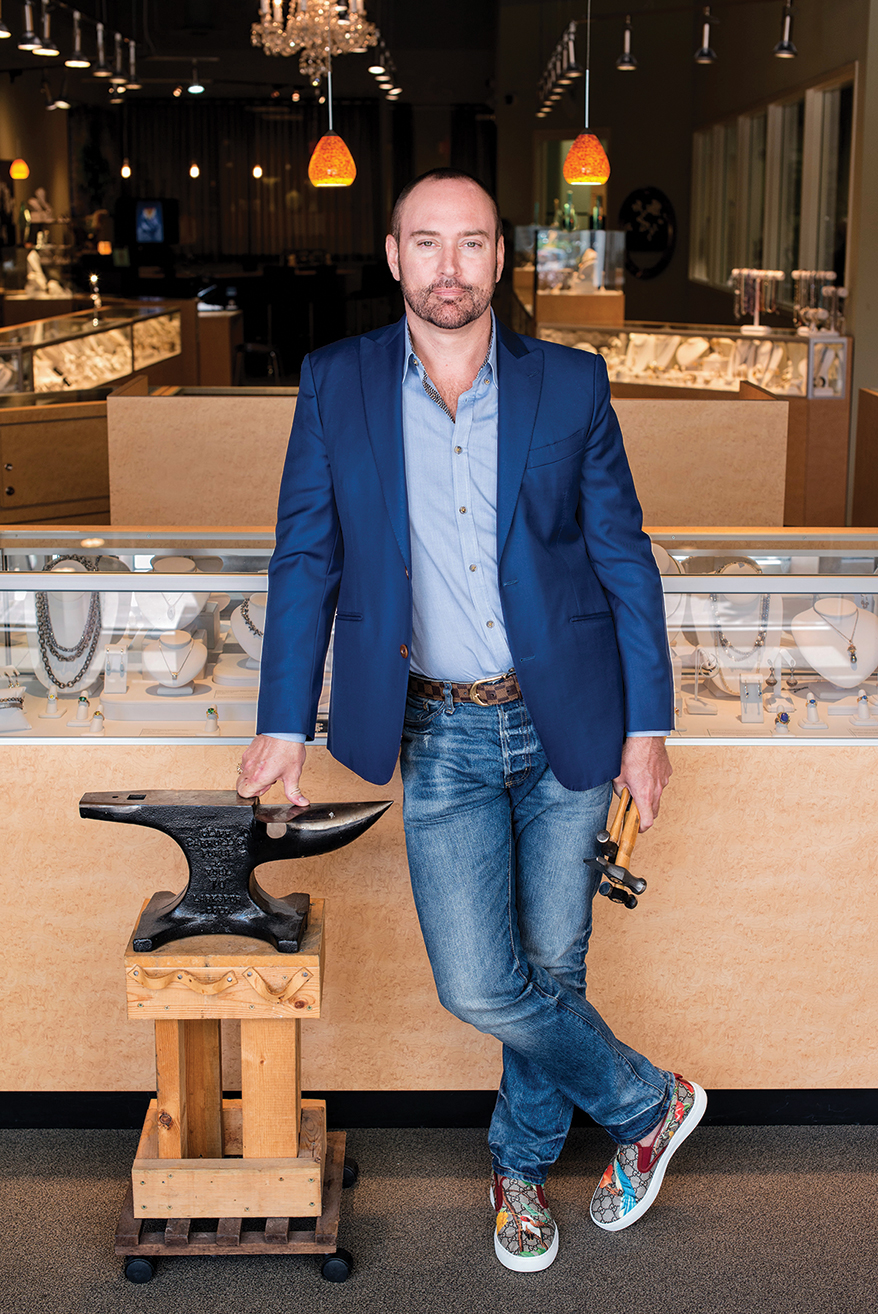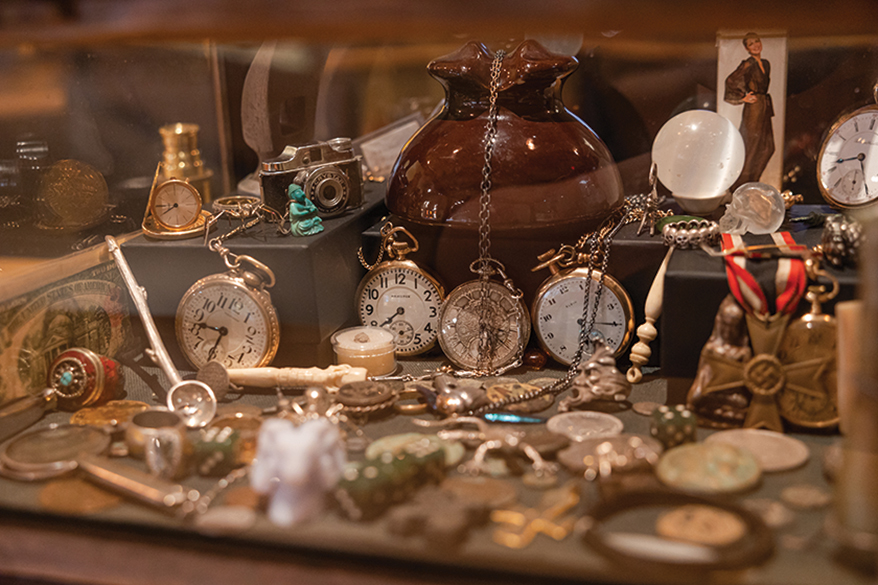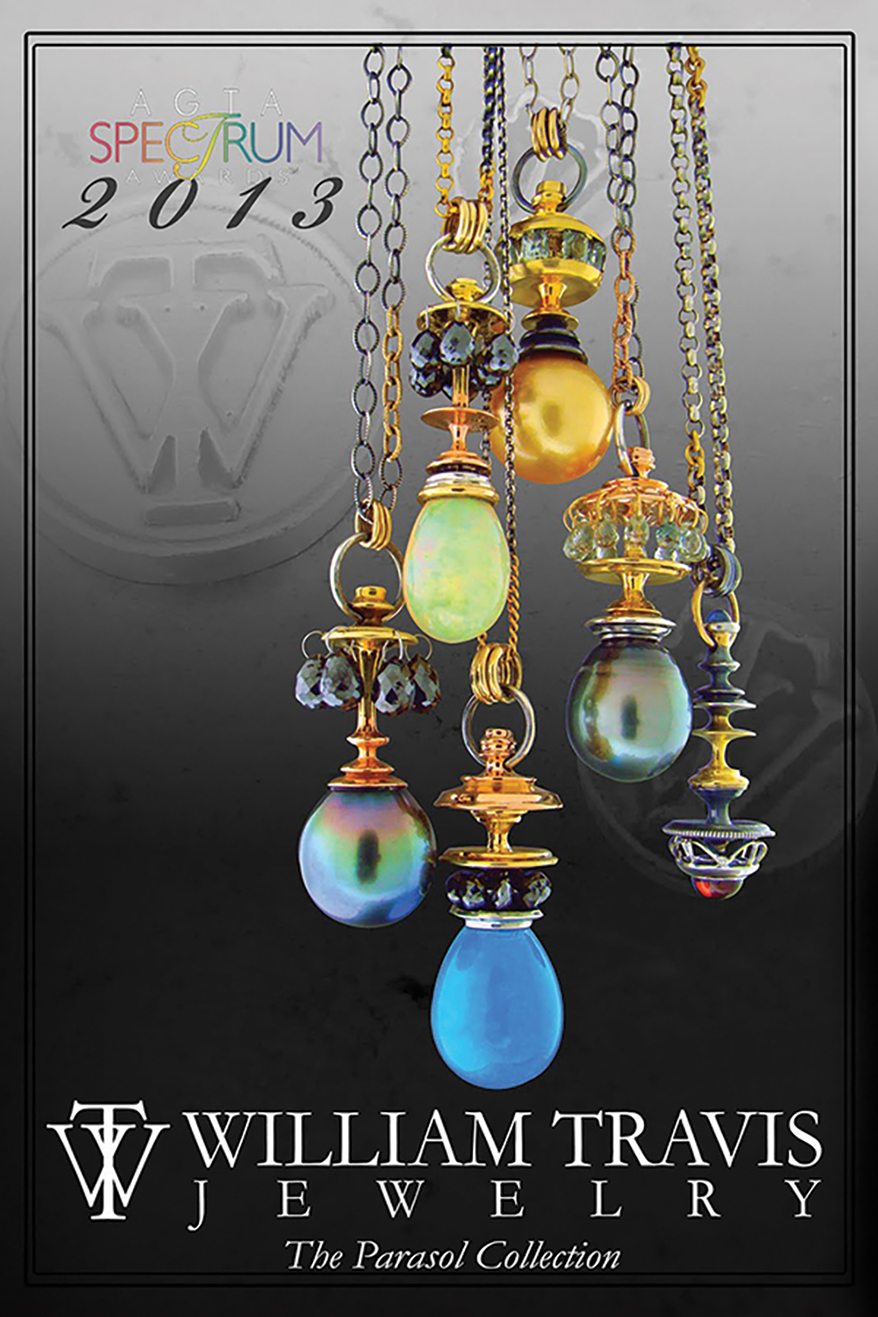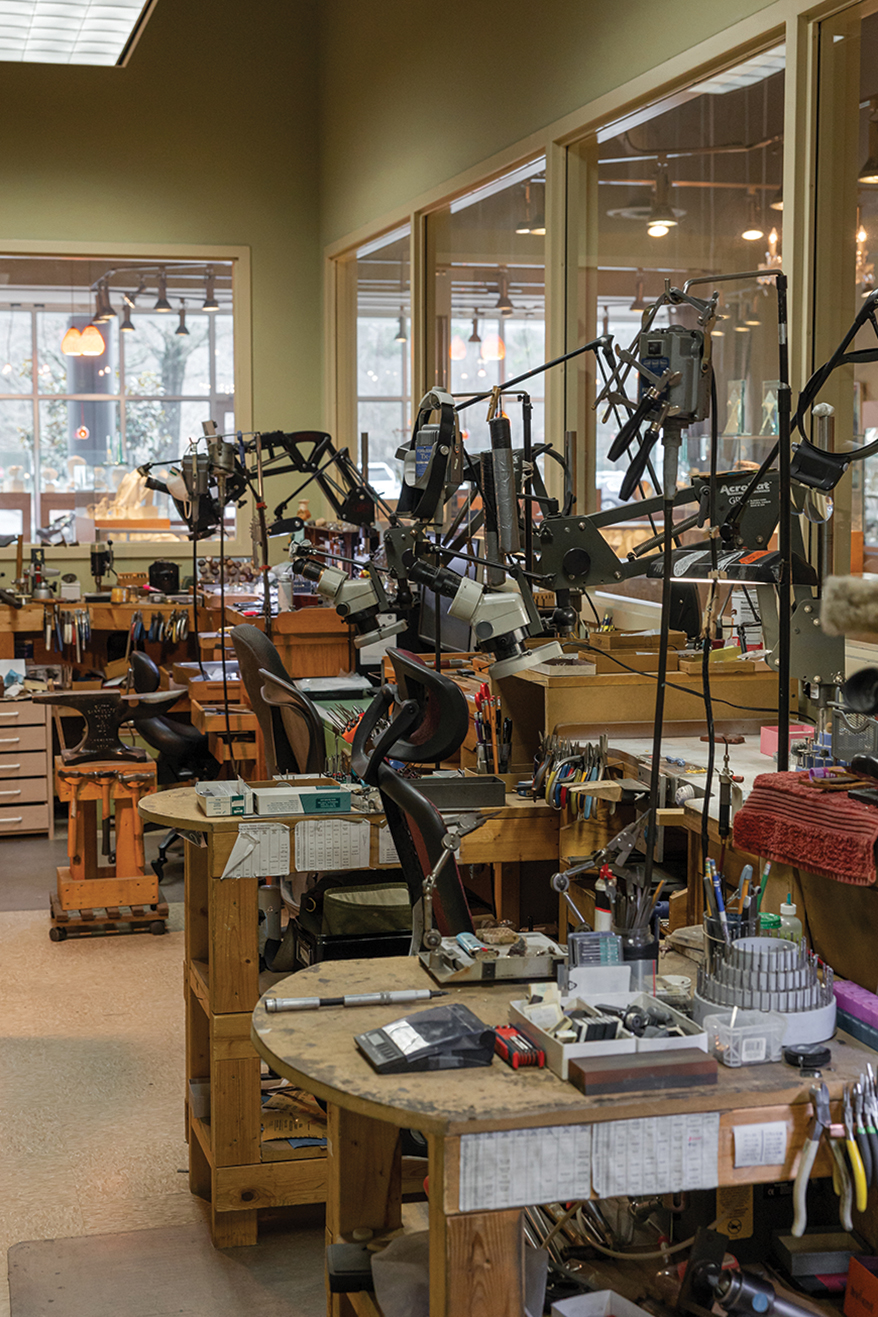William Travis Jewelry, Chapel Hill, NC
OWNER: : William Travis Kukovich; ONLINE PRESENCE: 4.1 Stars for 87 Google reviews; 4,200 Facebook followers; FOUNDED: 2003; Opened featured location: 2013; AREA: 3,267 square feet; EMPLOYEES: 4

William Travis Kukovich
WHETHER WILLIAM TRAVIS Kukovich is designing his environment or a new jewelry collection, he believes in moving forward.
That philosophy applies to the traffic flow of his store, William Travis Jewelry, which is designed along feng shui principles.
The showcase layout creates big circles and figure eights, so there’s nowhere for customers or energy to be trapped.
“Every room you walk into has a way out because you’re always moving forward,” he says. “You never have to stop and turn around to get out.”
Because shoppers tend to circle past cases two or three times, they are more likely to see something new on the next lap. Most customers are looking for inspiration since 90% of the business is custom design. They choose elements of pieces that catch their eye in the showcases in order to begin the design process.
His philosophy of moving forward in the showroom (and not getting stuck) applies equally to his jewelry creations. “I could easily make the same thing over and over again and sell it, but I don’t enjoy that. I want to move on to something new. Most of the things I make, I make only once.”
Advertisement
The positive energy in the store puts customers at ease.
“People are not particularly comfortable in jewelry stores,” he says. “Most jewelry stores when I was starting out were all dark wood, with guys in ties and jackets. I’m wearing jeans and a T-shirt and our cases are made of birdseye maple, there are light colors and a big bar.”
The casual approach has always worked well for Kukovich, but it’s even more popular post-COVID. “Now you see everybody coming in in yoga pants,” he says.
While the bar takes up a lot of space, it’s served him well. It’s built business and, after hours, encouraged employee camaraderie.
Male customers would rather sit at the bar and talk about the custom-design process than be pitched while standing over showcases under bright lights. “I think I might have the only jewelry store that men like to come in more than women,” he says. “They come in here all the time to see what I’m working on.”
In addition to a large bar, there’s a full kitchen, which was expensive to install, but well worth it from Kukovich’s perspective. “Working for other people, I always ate lunch at my bench,” he says. “Having a family atmosphere where you can sometimes eat together just feels better.” Staff will often stay and have a drink at the bar after work. “People get along and like each other, have a drink together, watch March Madness at our bar. It makes clients feel comfortable when they come in and see everyone comfortable with each other.”

A workshop behind a glass window creates full transparency and adds to the experience. Everything, from design and CAD mockups to casting, setting, and polishing, happens in-house.
Kukovich, the award-winning designer behind the jewelry he makes and sells, represents the first generation of his family born in the United States. He learned old-school metalsmith techniques from his grandfather and great-grandfather.
Each Saturday, a small crowd materializes to watch him melt metal and cast.
“The big torch and melting of metal are big eye-catchers. It’s akin to watching a blacksmith work, which is more what I was watching as a kid. Sparks and fire are what I loved as a kid. I usually will make a little something that day in front of them.”
He’s developed a new jewelry aesthetic, combining his signature forms and silhouettes with ancient textures and manufacturing techniques to meet a demand for milgrain, engraving and hammer finishing.
“I’ve taken contemporary designs that are in no way traditional in structure and put ancient finishes on them,” he says. “It has really made for something that you can’t find elsewhere.” This design celebrates the modernity of the current era while also evoking the mystery and heritage of ages past.
Inspiration doesn’t come overnight in a dream. “What happens is you make something, and you make a better version of it and another. You keep improving on it. It’s really a process, which is a key to having a successful design business. You have to sell your work.”
Kukovich sketches custom designs but doesn’t provide a detailed sketch or a CAD rendering before beginning a piece for a client. He also doesn’t take deposits, which is a policy that establishes trust, he says, since if the customer doesn’t like it, nothing is lost. It’s also exciting, he says, to accept payment when the client sees the piece for the first time and is “super happy.”
“I’ve only had one piece in my entire career that was not picked up; they ordered the piece, they liked it, but then for some reason, they felt like since they hadn’t paid a deposit, they wanted to negotiate the price,” he says. After a debate, he refused to sell it to them at any price. “It rubbed me the wrong way. They had their lawyer call and try to get the piece. I put it in the case and it sold within days. They were livid.”
Advertisement
AWARD-WINNING DESIGNER
Kukovich started metalsmithing at 8, described himself as being a true metalsmith by 13, and began winning design awards at 19. At 26, he won his first Spectrum Award, becoming the youngest person at that time to win one; he now has 18 to his name.
His true love is color. “Diamonds don’t do much for me; they’re something I use for accent stones,” he says. “Every award I’ve ever won, with one exception, was a colored stone piece or pearl.” Although he designs rings with diamond center stones, bridal and engagement rings represent just 10% of total sales.
All 18 of his Spectrum Award-winning pieces were designed for clients. “It started that way because I had no money to buy the perfect gemstones myself. A client would buy it, and I would ask for it back. I’m not doing it to win awards, but doing it so well you can win awards with it? I’m proud of that.”
Born in Texas, Kukovich graduated with a geology degree from Stephen F. Austin University in Nacogdoches, TX, then spent two years in technical training at the Texas Institute of Technology. “I’ve never taken an art class in my life,” he says. “That just kind of came naturally to me.”
He moved to North Carolina at 19, where he set up a custom design shop for an employer and stayed for 10 years. When he struck out on his own, he worked out of his garage for three years before securing a lease on his first 700-square-foot location in Chapel Hill, NC.
Demographics are favorable in the Research Triangle of North Carolina, with a high percentage of college degrees, two-income households and a widespread appreciation for art. The business began to grow. The latest location is more than 3,000 square feet.
Not carrying branded jewelry can be a blessing and a curse, he says.
“People have Louis Vuitton bags and Gucci shoes and belts. They want to have jewelry that you recognize. But that’s not who our clientele is. They want to have stuff that people say, ‘Where did you get that?’ They want you to notice it but not recognize it.
The key to success has been being everybody’s little secret.”

MODERN MARKETING
Kukovich and team share new designs and communicate with clients on Facebook. They especially love to post videos of recently finished rings. “These are informal, exciting videos highlighting what I finished on my bench that day,” he says. “Close-up videos of the finished or in-process pieces, held in the bench-dust-covered hands of the metalsmith who actually made the piece, are a testament to the genuine enthusiasm and joy that fuels our work ethic.”
Video also allows for the natural movement of the wearer, which is the basis of many of his designs. “Videos are invaluable as a method of capturing the play of light and form as the jewelry is worn,” he says.
The jewelry itself is his greatest marketing tool.
“We’re in an interesting business of making something that no one needs,” he says. “You have to make it so good that people want it more than they want granite countertops, patio furniture, or a new car. You have to be in love with what you do to make other people love it so much.”

Each piece from the collectible Parasol Collection is slightly different from the next and has its own personality.
Five Cool Things About William Travis Jewelry
1. EXPERTISE. Kukovich made a 5-pound bejeweled crown for a Netflix show called The Blue Crown, which he delivered in person to Morocco. “They searched the world for someone to make the crown,” he says. “When they can call anybody and they call you, it’s nice to be that guy. It does feel good and gives you credibility with your clients.” He also repairs ancient armor for the Smithsonian, including Civil War swords, and has consulted with the Antiques Roadshow on metal objects.
2. BEETLE MANIA. The North Carolina Museum of Art commissioned William Travis Jewelry for “The Art of the Scarab” exhibit. “We cast North Carolina native beetles in silver with gemstones for their exhibit,” Kukovich says. “These beetle species included rhino, dung, and wood beetles, among others.”
3. REPAIR PROWESS. In addition to making custom fine jewelry, the craftspeople at William Travis can also repair just about anything. “We have repaired numerous items ranging from grandfather clocks, phonographs, an ancient sword, a gumball machine, vintage watches, even a ventriloquist’s puppet.” Kukovich also crafted a method to fix and restore the microphone on the gramophone.

4. HELPING YOUNG JEWELERS. William Travis bench jewelers are active on community forums, such as Jewelers Helping Jewelers. “The information now shared on these forums was formerly considered ‘trade secrets’ and held as the proprietary knowledge of each individual jeweler. I am extremely enthusiastic about helping young jewelers in the industry grow their knowledge, and about the recent renaissance of digital knowledge bases.”
5. ARTIFACTS AS CASE DISPLAYS. Kukovich describes himself as a lifelong collector of beautiful and interesting things. His shop has become a gallery of both his work as a jeweler and his collection of oddities and antiquities. “The cases house an amalgam of artifacts and jewelry, some dating back to the B.C. era, which is where I find inspiration,” he says.
Advertisement
PHOTO GALLERY (6 IMAGES)
Try This: Teach Communication to the Next Generation
Kukovich’s teenage daughter, Veda, works weekends at the store on the sales floor. His son Liam, who is 18, works during school breaks and is learning metalsmithing. “They both bring their individual strengths to the store on the weekends, and I could not be more proud of their accomplishments,” he says. Liam is the sixth generation of metalsmiths in the family and can fluidly perform many custom jobs and repairs. Veda’s natural ebullience and people skills put customers immediately at ease. “They have a real leg up. My parents didn’t have affluent, well-educated friends or clients around, so when I got into the business, it was difficult for me to talk to people at first. They’ve been around it their whole life. If you want your kids to be in your business, you’ve got to bring them in and make them comfortable with clients. “